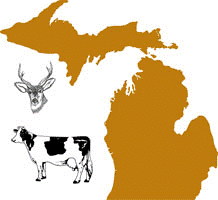Wildlife Disease and Zoonotics
Date of this Version
2004
Abstract
Livestock face complex foraging options associated with optimizing nutrient intake while being able to avoid areas posing risk of parasites or disease. Areas of tall nutrient-rich swards around fecal deposits may be attractive for grazing, but might incur fitness costs from parasites. We use the example of dairy cattle and the risks of tuberculosis transmission posed to them by pastures contaminated with badger excreta to examine this trade-off. A risk may be posed either by aerosolized inhalation through investigation or by ingestion via grazing contaminated swards. We quantified the levels of investigation and grazing of 150 dairy cows at badger latrines (accumulations of feces and urine) and crossing points (urination-only sites). Grazing behavior was compared between strip-grazed and rotation-grazed fields. Strip grazing had fields subdivided for grazing periods of <24 h, whereas rotational grazing involved access to whole fields for 1 to 7 d each. A higher proportion of the herd investigated badger latrines than crossing points or controls. Cattle initially avoided swards around badger latrines but not around crossing points. Avoidance periods were shorter in strip- compared with rotation-grazing systems. In rotation-grazing management, latrines were avoided for longer times, but there were more investigative contacts than with strip-grazing management. If investigation is a major route of tuberculosis transmission, the risk to cattle is greatest in extensive rotation-grazing systems. However, if ingestion of fresh urine is the primary method of transmission, strip-grazing management may pose a greater threat. Farming systems affect the level and type of contact between livestock and wildlife excreta and thus the risks of disease.


Comments
Published in J. Dairy Sci. 87:330–339.